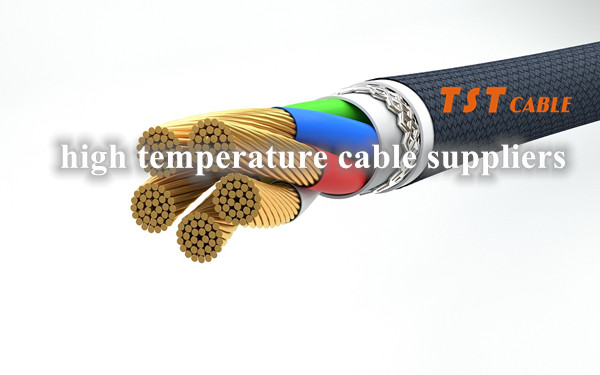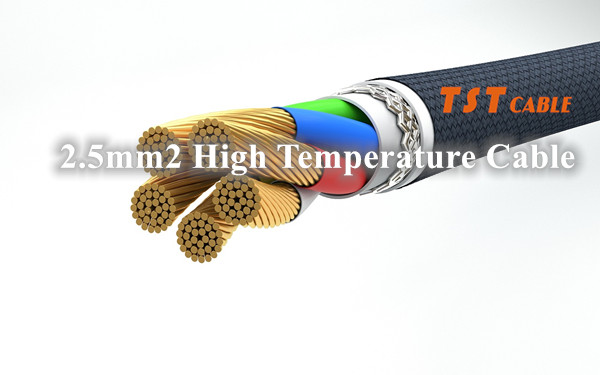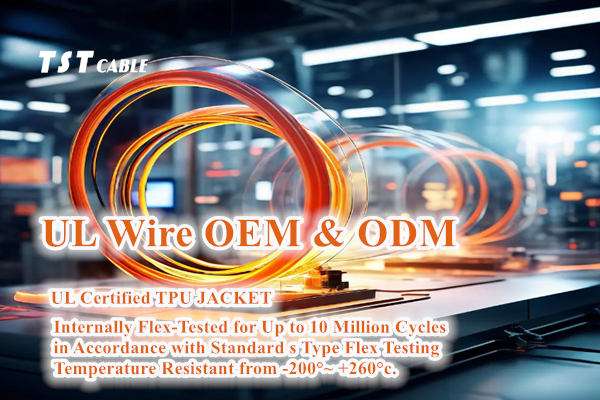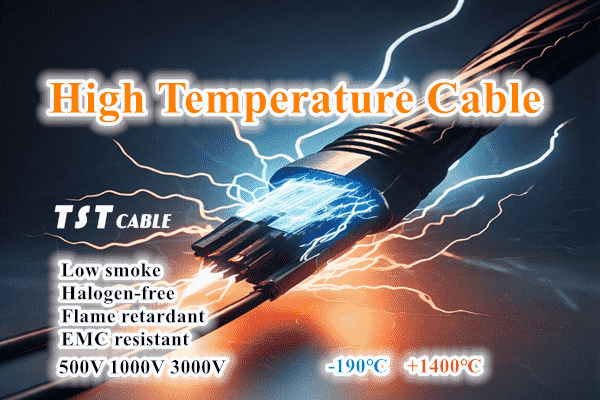
Cable engineering is a field of continuous innovation, with advances in technology and the demands of the global energy transition requiring increasingly high levels of performance, safety, environmental protection and intelligence.
TST CABLES has created an exhaustive glossary of cable engineering terms that synthesizes key industry standards and expertise from around the globe. The following is a compendium of selected high-temperature cable engineering terminology designed to cover the basics through to advanced terminology to aid in the understanding of key concepts in the design, manufacture, installation and maintenance of cables. Understanding and mastering this knowledge is an extremely valuable resource for those involved in cable design, manufacturing, installation, maintenance, and related research and management. As technology continues to advance, the field of cable engineering will continue to innovate to meet the future needs of society for efficient, safe, and sustainable energy transmission.
Basic Terms
Conductor: The part of a cable responsible for transmitting current, usually made of copper or aluminum.
Insulation: The material wrapped around the outer layer of the conductor to stop the leakage of current and to isolate the conductor from other conductors or from the outside world.
Sheath (Sheath/Jacket): The outermost protective layer of a cable to prevent physical damage and environmental factors from affecting the cable.
Shielding (Shielding): One or more layers of metallic material used to reduce the effects of electromagnetic interference (EMI).
Armouring (Armouring): metal braid or metal tape layer, to provide mechanical protection for the cable, commonly used in underground laying or vulnerable to external damage to the environment.
Single Core Cable: Cable containing only one conductor.
Multi-core cable (Multi-core Cable): cable contains two or more conductors side by side.
Voltage Rating: The highest working voltage that a cable is designed to withstand safely.
Current Carrying Capacity (Current Carrying Capacity): the maximum current that can be continuously transmitted by the cable without exceeding the permissible temperature rise.
Cross-sectional Area: The area of the cross-section of the conductor, which directly affects the current-carrying capacity of the cable.
Advanced terms
Cross-linked polyethylene (XLPE): An insulating material in which a cross-linking structure is formed between polyethylene molecules by chemical or physical means, improving heat resistance and mechanical strength.
Polyvinyl Chloride (PVC): A commonly used insulation and sheathing material with good chemical resistance and low cost.
Polyurethane (PU): a soft, abrasion-resistant sheath material suitable for frequent movement and bending occasions.
Fire-resistant cable (Fire-resistant Cable): cable that can maintain normal operation for a certain period of time under fire conditions.
Oil-resistant cable (Oil-resistant Cable): designed for use in oil-contaminated environments, with insulation and sheath materials resistant to oil erosion.
Weather-resistant cable (Weather-resistant Cable): suitable for outdoor use, can resist ultraviolet rays, moisture and temperature changes.
Control Cable: Cables used to transmit control signals or low-power electrical signals.
Power Cable: Mainly for high current transmission, such as power transmission and distribution systems.
Telecommunication Cable: Used to transmit data and voice signals, including fiber optic cables and twisted pair cables.
Coaxial Cable: consists of two layers of conductors inside and outside, separated by insulating material, suitable for high frequency signal transmission.
Design and construction terminology
Cable Laying: The process of installing cables on a predetermined path.
Cable Trench: An underground passageway excavated for cable laying.
Cable Tray: Support structure for overhead installation of cables.
Cable termination (Cable Termination): electrical connection and protection at both ends of the cable.
Joints (Joint): connecting the two sections of the cable to ensure electrical continuity and mechanical strength.
Cold Shrink Termination (Cold Shrink Termination): The use of elastic material pre-expansion after cooling contraction to seal the cable terminal.
Heat Shrink Termination (Heat Shrink Termination): The use of heat to tighten the material to complete the sealing and insulation of the cable terminal.
Earthing: Connecting the metal sheath or armor layer of the cable to the earth to ensure safety.
Tests and Standards
Voltage Test: To verify whether the cable insulation can withstand a predetermined voltage without breakdown.
Leakage Current Test: Measure the current through the insulation layer of the cable under the working voltage to evaluate the insulation performance.
Pulse Voltage Test: Simulates a lightning strike or electromagnetic pulse (EMP) to test the transient overvoltage capability of a cable.
EMC Test (Electromagnetic Compatibility Test): Evaluates the compatibility of cable systems in the electromagnetic environment, including emission and immunity tests.
IEC Standards (International Electrotechnical Commission Standards): A series of standards for electrical and electronic equipment developed by the International Electrotechnical Commission, widely used in the cable industry.
In-depth terminology and technology
Water Blocking Layer: Special materials are incorporated into the cable structure to prevent water from entering along the cable and to improve the reliability of the cable in wet environments.
Phase-Separated Sheathed Cable (Phase-Separated Sheathed Cable): In multi-core power cables, each phase conductor is individually wrapped in a sheath to minimize phase-to-phase interference and improve safety.
Self-contained Oil-filled Cable: Cables filled with insulating oil with pressure system for high voltage transmission to improve insulation and heat dissipation.
Optical Fiber Cable (Optical Fiber Cable): transmits optical signals instead of electrical signals, consists of optical fibers, reinforcing elements and sheaths, and is suitable for long-distance, high-speed data transmission.
Pre-branching Cable: Pre-made branching structure of the cable in the factory to simplify on-site installation, commonly used in lighting systems.
Torsion-resistant cable: Designed for frequent torsion movements, such as robot arms, with special structures and materials to minimize torsion damage.
Mineral Insulated Cable (MICC): With magnesium oxide as the insulating material and copper tubing as the sheath, it has excellent fire resistance and is suitable for fire fighting and other safety-critical applications.
Conductor stranding (Stranding): multiple strands of fine wires are stranded into one strand to enhance the flexibility and mechanical strength of the cable.
Earth Wire/Ground Wire: The conductor in the cable system is specially used for grounding to ensure the safety and stability of the system.
Equipotential Connection (Bonding): Connecting different metal parts or metal sheaths of cables to reduce the potential difference and prevent galvanic corrosion or electrostatic buildup.
Cable Management System (Cable Management System): Including cable trays, bridges, raceways, etc., for organizing, fixing and marking cables to improve maintainability.
Safety and Regulations
Cable Ampacity Calculation: Calculates the maximum current that can be safely transmitted by a cable based on factors such as cable type, ambient temperature, and laying method.
Cable Path Tracing: Utilizes the electromagnetic field principle to locate the direction of buried cables for ease of construction and maintenance.
Thermal Imaging Inspection (Thermal Imaging Inspection): Check the temperature distribution of cables and connection points through infrared thermal imaging technology to prevent overheating faults.
Cable Marking: Marking information such as specification, number and usage on the cable for easy identification and management.
Cable Fire Barrier: Prevents fire from spreading to the cable system, protecting critical equipment and personnel.
NEC Standard (National Electrical Code): The U.S. National Electrical Code provides safety standards for electrical installations, including cable selection and installation requirements.
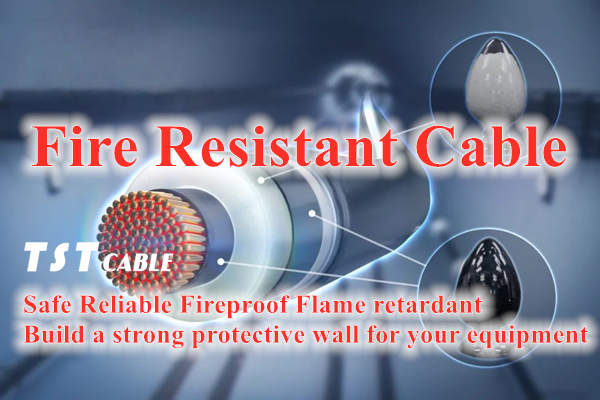
Environment and Sustainability
Green Cable: Made of environmentally friendly materials, such as low-halogen and halogen-free flame retardant materials, to reduce environmental pollution.
Recyclable Cable: Designed for easy recycling to reduce waste of resources.
Energy Efficiency (Energy Efficiency): refers to the cable in the transmission of electrical energy in the process of low loss, help energy saving and emission reduction.
Eco-label (Eco-label): awarded to those products that have a low impact on the environment, cables with this label, indicating that their production, use and disposal process are in line with environmental standards.
Smart Grid and Communications
Smart Cable: Built-in sensors or fiber optics enable real-time monitoring of cable status, such as temperature, stress, etc., supporting remote monitoring and preventive maintenance.
Power Line Communication (PLC, Power Line Communication): Utilizes power lines as a communication medium to achieve data transmission, suitable for smart homes and smart grids.
Distributed Temperature Sensing (DTS, Distributed Temperature Sensing): Through fiber optic technology, continuous monitoring of temperature along the cable is achieved, which helps in early detection of potential fault points.
Maintenance and Fault Diagnosis
Online Monitoring: Real-time monitoring of electrical parameters and physical status of cables without power outage.
Partial Discharge Testing: Detecting weak discharges in the cable insulation layer is an important means of assessing the health of the cable.
Cable Fault Location: Determine the location of cable faults through acoustic waves, voltage pulse reflections and other methods.
Cable Repair (Cable Repair): Repair of damaged cables, including insulation repair, joint redoing, etc., to restore their normal function.
High-tech applications
Superconducting Cable (Superconducting Cable): Transmits electricity without resistance at ultra-low temperatures, suitable for large-capacity power transmission and reducing transmission losses.
Optical Fiber Composite Overhead Ground Wire (OPGW, Optical Fiber Composite Overhead Ground Wire): integrated with fiber optic communication function of the overhead ground wire, both power transmission and data communication dual role.
Wireless Charging Cables: Despite its contradictory name, Wireless Charging Cables actually refers to the transmission coils used in wireless charging systems to realize non-contact energy transmission.
International Certifications and Standards
UL certification cable(Underwriters Laboratories): Underwriters Laboratories’ safety certification ensures that products comply with North American safety standards.
CE marking cable (Conformité Européene): Indicates that the product meets the safety, health and environmental requirements of the European Union for products destined for the European market.
VDE certification cable (Verband der Elektrotechnik, Elektronik und Informationstechnik): Certification by the Association of German Electrical Engineers, which stands for high quality and safety standards.
International Electrotechnical Commission (IEC) cable: Develops international standards for electrical and electronic technology to promote global trade and safety. Cable standards such as IEC 60227 and IEC 60502 are widely adopted.
ISO standards cable (International Organization for Standardization): international standards covering various aspects of cable manufacturing, quality management and environmental performance, such as ISO 9001 quality management system.
EN Standard cable (European Standard cable): refers to the European standard, which is developed and issued by the European Committee for Standardization (CEN). The EN standard covers technical specifications in various fields, covering requirements ranging from the quality of products and services to engineering, safety, environment, information technology, energy, and medical equipment.
Advanced Materials and Technology Innovation
Carbon Nanotube Conductor (Carbon Nanotube Conductor): utilizing the excellent electrical conductivity of carbon nanotubes, the development of a new superconducting, lightweight cable materials, with potentially revolutionary applications.
Liquid Metal Alloy (Liquid Metal Alloy): Used in cable joints or the conductive part of special cables to improve conductivity and durability, especially in high temperature or extreme conditions.
Shape Memory Alloy (Shape Memory Alloy, SMA): Used in the automatic repair of cables or adaptive structure, according to the temperature or electric field changes to restore the original shape, to enhance the self-repair ability of the cable.
Aerogel Insulation (Aerogel Insulation): With extremely low thermal conductivity and excellent insulation properties, it is suitable for high-voltage cables and cable insulation in extreme environments.
Cable System Design and Optimization
Cable Routing Planning: Designs optimal cable routing paths based on building or terrain characteristics to minimize costs and improve efficiency.
Cable Load Calculation Software (Cable Load Calculation Software): assist engineers in calculating the performance of cables under different load conditions to optimize the design.
3D Cable Routing: Uses three-dimensional modeling technology to design cable routes, accurately preview installation results, and reduce on-site adjustments.
Modular Cable System (Modular Cable System): design flexibility, easy to expand and replace the cable components, improve the system’s maintainability and adaptability.
Cable Installation and Maintenance Tools
Cable Puller: Used for long distance or heavy load cable laying, reducing human labor.
Cable Cutter and Stripper: Specialized tools to ensure that cutting and stripping the outer skin of the cable will not damage the internal conductors.
Crimping Tool: Used to make cable joints to ensure the reliability and durability of electrical connections.
Hot Air Gun: Used in the installation of heat-shrink cable terminations and splices to heat the material to tighten it and form a seal.
Energy and Renewable Energy Applications
Submarine Cable: Used for trans-oceanic power transmission or submarine communications, highly waterproof, corrosion-resistant and able to withstand deep-water pressure.
Wind Farm Cable: Designed for wind power generation systems, it is resistant to flexing and salt spray corrosion, and adapts to harsh outdoor environments.
Photovoltaic Cable: Used for the connection of solar photovoltaic system, with UV resistance, high temperature resistance and flame retardant characteristics, to ensure long-term stable work under direct sunlight.
Intelligent Monitoring and Management System
Cable Health Monitoring System (Cable Health Monitoring System): integrated sensors and data analysis technology, real-time monitoring of cable electrical parameters, temperature, vibration, etc., to prevent failure.
Internet of Things (IoT, Internet of Things) in cable management: Through IoT technology, cables and their accessories are transformed into intelligent devices, realizing remote monitoring, predictive maintenance and optimal allocation of resources.
Big Data Analytics (Big Data Analytics): collect and analyze large amounts of cable operation data, identify patterns, optimize cable maintenance plans, and improve system efficiency.
Disaster Prevention and Response
Flood-resistant cable: Designed for use underwater or in flood-prone areas, the cable has excellent waterproof sealing performance to ensure that it can still work properly under flooded conditions.
Seismic-resistant cable system (Seismic-resistant Cable System): using special fixing and supporting technology to ensure the stability and safety of the cable system in the event of an earthquake.
Fire-resistant cable: maintains circuit integrity for a period of time in the event of a fire, providing security for emergency evacuation and power supply to critical equipment.
Environmental adaptability and durability enhancement
Chemical-resistant Cable (Chemical-resistant Cable): Designed for use in chemical plants, laboratories and other corrosive environments, the outer sheath and insulation are made of special materials to resist acid and alkali and other chemical substances.
UV-resistant Cable: Cables for use in outdoor exposed environments with excellent UV aging resistance and extended service life.
Salt Mist-resistant Cable (Salt Mist-resistant Cable): For seaside or offshore applications, it prevents salt mist corrosion and ensures stable operation of cables in highly salty air.
Cable System Safety and Compliance
Cable Fire Rating: Rating the performance of cables under fire conditions based on the results of combustion tests, such as the IEC 60332 series of standards.
Explosion-proof Cable (Explosion-proof Cable): Used in flammable and explosive environments, such as mines, oil platforms, etc., designed with a special protective structure to prevent sparks from causing explosions.
Electromagnetic Compatibility (EMC, ElectroMagnetic Compatibility): Ensure that the cable can effectively transmit signals in the electromagnetic environment, but also free from external interference, to meet specific EMC standards.
Cable Recycling and Circular Economy
Cable Recycling Process (Cable Recycling Process): Includes the steps of collection, classification, dismantling, and extraction of valuable materials, aiming to reduce the waste of resources and promote the development of circular economy.
Environmentally Friendly Recycling Technologies: R&D of low energy consumption, harmless treatment of cable waste technology to reduce secondary pollution in the recycling process.
The future direction of cable technology development
Microgrid Cables: Cable solutions that support localized energy production and consumption are essential for improving energy efficiency and grid flexibility.
Quantum Communication Cables: Exploring cable technologies that utilize phenomena such as quantum entanglement for ultra-secure communications, which could become key to information security in the future.
Sustainable Materials Research: Developing greener, recyclable cable materials to reduce the environmental impact of the cable life cycle and address global climate change challenges.
Commercialization of superconducting materials: With the maturity of superconducting technology, superconducting cables are expected to be commercialized in the field of long-distance, high-capacity power transmission, which will greatly improve the efficiency of power transmission.
Energy Harvesting Cable: Utilizing the energy of the cable itself or the surrounding environment (e.g., temperature difference, vibration), the cable monitoring system or small equipment power supply to achieve self-sufficiency.
Artificial Intelligence and Cable Maintenance: AI algorithms analyze massive amounts of data to predict cable failures, optimize maintenance strategies, reduce unplanned downtime, and improve O&M efficiency.
The above cable engineering terms and concepts outline all aspects of cables from basic to advanced, from traditional to cutting-edge, reflecting the depth, height, breadth and endless fascination of cable technology.
Cable engineering technology is an essential part of the infrastructure of modern society, and its level of development is directly related to the efficacy of energy transmission, the quality of communications, and numerous industrial applications. From the selection of basic materials to the application of advanced manufacturing technology, to intelligent management and environmental protection, every step of progress reflects mankind’s pursuit of more efficient, safer and greener cable systems. In the face of future challenges, such as the global geo-crisis, energy transition, environmental crisis and the advent of the digital era, TST cables continues to explore and innovate, and to use the power of science and technology to drive the industry in the direction of a healthier, more sustainable, and smarter industry.
Also available in:
English



